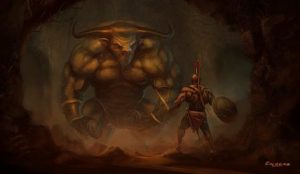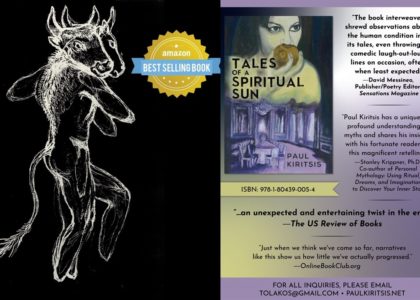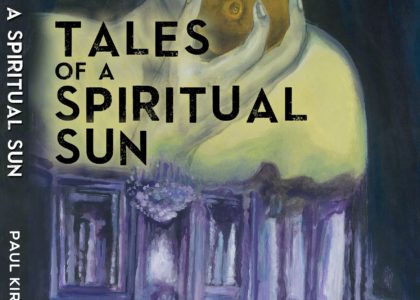
In ancient times, one could gain entrance into the temple-palace of Cnossos by following the paved Royal Road that runs perpendicular to the east bastion. For a foreigner entering the open air theatre for the first time, the sheer size of the structure and its advanced technological feats would have been awe-inspiriting and constituted something of an ethereal experience. Given this, it’s not difficult to see how the temple-palace’s host of meandering passages, its iconography of the goddess of innumerable forms and her bull-god consort, the winding stairwells and the gargantuan proportions of the three and four-story complex would have conspired with the imagination of a great many to implicate Cnossos as the seat of unruly and sinister operations. In fact, I would probably go as far as to proclaim that the only remaining myth we have relating to the Minoan culture was synthesised by the more imaginatively inclined and credulous amongst the Mycenaean sailors who visited Cnossos sometime after the incursions of the sixteenth century bce.
The myth to which I refer, a fantastical tale of a subterranean labyrinth built to imprison a theriomorphic creature in the Minotaur, is a leading mythological exponent of the classical world that anybody with a passing interest in Aryan Greek culture is bound to run into sooner rather than later. What most don’t seem to realise is that the story itself is told from the perspective of the victor, the Mycenaeans, who sought to express their subjugation of a native culture based on lunar-psychic and matriarchal sentiments through the instalment of a social hierarchy underpinned by a line of god-orientated male monarchs who based their entire cosmogony on solar-spiritual religion. The inauguration of the masculine aesthetic hierarchy typified by division into classes is symbolically conveyed by the birth and ascension of King Minos, one of three sons to be born to the bull-god Zeus and his consort Europa. Similarly, the myth unconsciously appropriates sacred matriarchal images in its attempt to strip the Great Mother Goddess of her numinosity and reassign this cosmogonic element to a purely male Godhead. By transposing the Hieros Gamos or Sacred Marriage of the Great Mother Goddess and her bull-consort to the literal level and re-membering or re-creating it into a horrendous bestial act between a mortal woman and an animal, the narrative degrades the sanctity of an astronomical affair that was celebrated by the astronomer-priestesses of Cnossos. In retrospect, it appears that what probably began as a story told between Mycenaean sailors stationed at ports to pass the time traversed the centuries as an oral fabrication before beaching itself upon the Aryan Greek consciousness of eighth century epic poet Homer, as well as Hesiod, Thucydides and Pindar, all of whom preserved the Mycenaean point-of-view in their epic and lyrical writings. The story itself, as vastly biased, two-dimensional and cosmologically disfigured as it is, is the only tangible memory of the Minoan vision that has ever come to light.
According to this classical legend, a beautiful young princess by the name of Europa was traversing the Phoenician shoreline in search of flowers one day when she was sighted by the omniscient Zeus from his throne atop Olympus. The mighty Zeus, who succumbed to his carnal lusts and desires frequently, was so taken aback by her dazzling beauty that he went about devising a cunning machination to seduce her. He proceeded to morph into a snow-white bull and approached her where she lay, convinced that the disguise would lull the princess into a false sense of security. At first, Europa regarded the creature with suspicion but the bull’s benevolent and playful disposition soon put those fears to rest. Before long, she had grown so bold as to mount him. This was exactly what Zeus had been hoping for. He took off as soon she’d clambered onto his back, traversing the Aegean Sea at the speed of a lightning bolt and bringing her to his island home of Crete. There, he assumed a more anthropomorphic form and revealed himself as the father of the Olympian gods and goddesses. Their subsequent union produced three sons–Minos, Rhadamanthus and Sarpedon–all of whom were destined to become kings. Lamentably, it wasn’t long before the promiscuous Zeus abandoned Europa for the thrill of another chase, and the princess of Phoenicia had to make do with a husband in Asterios, the man who was ruling Crete from the palace of Cnossos at that point in time. When Asterios died, Minos succeeded him as king.
The rule of Minos is reputed to have been a prosperous and peaceful one. Minos married Queen Pasiphae, herself the progeny of the sun god Helios and the nymphs Perseis, and together they sired eighth children–Ariadne, Androgeus, Deucalion, Phaedra, Glaucus, Catreus, Acacallis and Xenodike. As was usually the case with patriarchal monarchies of Aryan Greek culture, there came a time when the enmity of his two jealous brothers brought Mino’s divine right to rule Crete under question. He adjourned the matter for some time before deciding that the best way to dispel all doubts was to implore the sea god Poseidon to deliver a sacrificial bull. No doubt the act of divine cogitation on the god’s behalf would vindicate his supreme right to rule. The magical incantation ensued in bittersweet consequences. In granting the wish Poseidon did in fact affirm Crete to be Minos’s personal fiefdom, but it just so happens that the bull which rose from the froth of the seas was so supernal, so magnificent, such a brute of a specimen, that Minos perished all thoughts of ever losing it and sacrificed another in its stead. In succumbing to a weakness for beauty so indigenous to the fallacies of the human condition, Minos incurred the wrath of Poseidon who dutifully punished the ruling dynasty by inciting within Pasiphae an unnatural lust for the sacrificial creature.
Desperate to act out her fantasy, Pasiphae went behind her husband’s back and persuaded the architect of Cnossos, Daedalus, to construct a wooden contraption in the guise of a living cow as to facilitate sexual union between the two disparately related beings. One night, Pasiphae struck an apt pose so that her hind quarters were hidden inside the bovine legs of the wooden cow and her pudendum was clearly visible. On the whole, her many attempts to rouse the bull’s attention and stir the creature sexually were successful. The fruit of their union was a theriomorphic beast that was part-human and part-bull. Many versions of the myth claim that Pasiphae named her progeny Asterion, though it was more commonly referred to as the Minotaur. The Minotaur was so frightening in appearance that the ingenuity of Daedalus had to be called upon once more, this time to build a subterranean labyrinth in which the monstrosity might be imprisoned to keep it from the prying eyes of the Cnossian populace.
Minos wasn’t at all fond of the Minotaur. In fact, he abhorred it because it served as an incessant reminder of his wife’s bestial act and infidelity. Nonetheless, he was adroit enough to realise that its carnivorous habits could be put to some practicable use by terrorising the citizens of nations subdued by his thalassocracy into utter submission. Hence when Minos succeeded in a naval campaign against the state of Athens, he demanded that the newly appointed vassal state pay its dues with an annual tribute of seven boys and seven maidens, all of whom would be thrown into the underground labyrinth to meander about until fate brought them face to face with the flesh-devouring jaws of the Minotaur.
Logically, it wasn’t long before rumours of the bloodcurdling events unfolding in the man-made maze beneath the palace of Cnossos reached Athens. The rumours were enough to incite a hair-raising chill along the spine of any mortal, save for one; the valiant and noble Theseus, son of King Aegeus. Eager to end years of tyrannical rule and exorcise the memory of his own mother having engaged in the same despicable act as Queen Pasiphae, Theseus willingly steps forth as one of the fourteen youths to embark on a dangerous voyage from whence there might be no return. Fortunately his good looks where to make fruitful the endeavour, for when he disembarked at the port of Amnissos the muscle-bound, bronze-skinned Theseus caught the eye of King Minos and Queen Pasiphae’s daughter, Ariadne, whose conditional offer proved instrumental to his success.
Conspiring against the will of her own father, Ariadne equipped Theseus with a skein of thread which he proceeded to tie at the maze entrance and unwind as he ventured deeper and deeper towards the heart-centre, following the serpentine paths that the labyrinth mapped out. A gruelling combat unravelled near the centre, where Theseus succeeded in decapitating and hacking the monstrosity to bits. From there, the action of winding the thread back up enabled him to find his way back out without ever losing his bearings. Theseus then frees the Athenian prisoners and flees to the island of Naxos, taking the love-struck princess with him. Some versions of the myth have Theseus forgetting Ariadne on Naxos whilst she slept complacent on the beach; whilst others claim that the desertion was premeditated seeing that Dionysus had appeared to Theseus in a dream demanding that he leave her there.
The most tragic part of the tale is without a doubt the end. It had been preordained that Theseus would hoist white sails on the masts of his ship should he return triumphant in having slayed the Minotaur. An honest oversight on his behalf was to have catastrophic consequences, for when King Aegeus of Athens saw the ship approaching the Athenian acropolis from afar decked in the black of mourning he immediately took the cue to mean that his son had perished during the encounter. King Aegeus’s despair was such that he took his own life, hurling himself from the treacherous cliffs into the sea. The sea was henceforth named the Aegean in memory of the king’s self-sacrifice.
Back in Cnossos things had taken a turn for the worse. Minos, furious at Daedalus for repeated offences against the throne that included helping queen Pasiphae consummate her unnatural lust and aiding and abetting Theseus and Ariadne with the ball of woollen thread, barred the architect from ever leaving the fated city. Once again Daedalus turned to the brilliance of his inventive mind to find answers, just like he’d done numerous times before. If he couldn’t sail out of Cnossos, he’d fly out. It was as easy as that. He carried out his remarkable plan with ample amounts of beeswax taken from the temple repositories and feathers which he collected from the Cretan shore with the help of his son Icarus. Using the materials, they fashion two pairs of wings and strapped them to their backs using elongated animal skins. Before their maiden flight, Daedalus warned his son against the inherent dangers of flying too high or low; too high and the sun’s heat would melt the beeswax, too low and the feathers would become saturated with moisture from the sea. Being of an adventuresome and daring disposition, Icarus snubbed his father’s warning, soaring higher and higher until the sun’s heat stripped his wings bare of feathers. Powerless to help, the distressed Daedalus watched on from a short distance away as his son plunged to his death. The waters in which he fell became known as the Icarian Sea, and the island on which his naked body was washed was named Icaria.
Hence the fates of Theseus and Daedalus mirror one another. In both cases, their success in reaching the Grecian mainland was an utterly bittersweet affair, keeping in line with a primordial divinatory belief amongst the Hellenes that the “fates” never ordained entirely auspicious fortunes to anybody.









